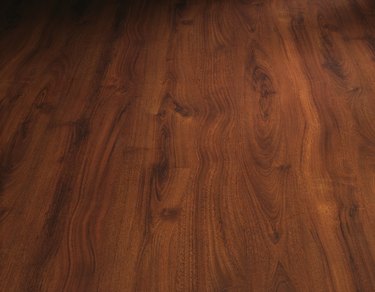
The makers of many types of polyurethane, a durable wood finish available in water-based and oil-based formulas, recommend using a lambswool pad to apply the product. Applying polyurethane with a lambswool applicator is common for wood floors but can be chosen for other wood-finishing projects as well, such as refinishing furniture. Available in various shapes and sizes, lambswool applicators offer a smooth, streak-free finish but might be befuddling to anyone unfamiliar with them. For a first-timer, these tools should be quite straightforward to use, but it helps to understand the nuances of lambswool.
Choosing a Lambswool Pad
Video of the Day
Lambswool pads or rollers are used with matching applicators, so be sure to buy the correct combination of tools. Options include block applicators, which wrap replaceable lambswool pads around a block of wood and feature a handle. These are available in various sizes, with hand-held versions for up-close work and long-handled versions designed for finishing floors from a standing position. Lambswool rollers are similar to regular paint rollers and need a roller frame with a long or short handle plus a paint tray.
Video of the Day
Be aware that some lambswool pads and rollers are synthetic, whereas others are 100 percent genuine lambswool. Synthetic lambswool pads are only suitable as water-based floor finish applicators and not oil-based polyurethane applicators. Check the labels to avoid mishaps. Also check the polyurethane manufacturer's instructions regarding use of rollers, as some products are not suitable for roller application. Choose tools with which you feel comfortable and be sure to buy more than one lambswool pad if you intend to apply multiple coats of polyurethane, as it's best to use a new pad for each coat.
Preparing a Lambswool Pad
One drawback of lambswool pads is that they sometimes shed fibers and fuzz that get stuck in the wet polyurethane. Before using a new pad as an oil-based or water-based floor finish applicator, vacuum it with a nozzle attachment, brush it with a dry paintbrush and then press and quickly pull off strips of painters' tape to remove as many loose fibers as possible.
Applying Polyurethane to Floors With Lambswool
Things You'll Need
Protective gloves
Sandpaper
Stain (optional)
Vacuum
Lint-free cloth
Mineral spirits (if needed)
Painters' tape
Oil-based or water-based polyurethane
Wooden stirrer or stick
Lambswool pads
Block applicator with handle
Paint tray (if needed)
Paintbrush
Step 1
Open windows and turn on fans for ventilation and wear protective gloves.
Step 2
Prepare the floor or other wood surfaces to be finished by sanding and optionally staining them. Vacuum, dust and wipe down the wood with a lint-free cloth dampened with water if you will be using water-based polyurethane or mineral spirits if you will use oil-based polyurethane.
Step 3
Cover baseboards and any other adjacent features with painters' tape.
Step 4
Stir the polyurethane with a wooden stirrer or stick, stirring slowly to avoid introducing air bubbles.
Step 5
Starting in a corner farthest from the exit door, apply the polyurethane along the floor adjacent to the wall following the direction of the wood grain. There are two different approaches to this task:
- Pour some polyurethane in a small puddle directly on the floor several inches away from any wall and trail some along the direction of the grain for a few feet. Sweep the lambswool applicator through the puddle and along the line of polyurethane so that the product thoroughly coats the flooring.
- Pour polyurethane in a paint tray and saturate the lambswool applicator with the product. Sweep the applicator along the edge of the wall in the direction of the grain so that the product thoroughly coats the wood flooring.
Step 6
Whichever method you choose, continue applying polyurethane to floors with lambswool in long sweeps along the grain, starting and stopping at the walls whenever possible and not in the middle of the floor.
Step 7
Pivot back to apply polyurethane in the opposite direction when you reach one wall, overlapping the previous sweep by about a third.
Step 8
As you work at applying polyurethane with a lambswool applicator, fill in any missing spots with a paintbrush. Use a natural-bristle brush for an oil-based product and synthetic for a water-based product.
Step 9
Let the first coat dry, which typically takes one to two hours for a water-based floor finish application and up to 12 hours for an oil-based finish.
Step 10
If you intend on applying polyurethane to floors with lambswool in multiple coats, sand the previous coat, vacuum and wipe up the dust. Apply polyurethane with a new lambswool applicator in the same way you did the first coat. Repeat until you're satisfied with the finish.
Cleaning a Lambswool Pad
Clean lambswool pads for reuse in the future. If you used water-based products, clean the pad with water and dish soap. If you used an oil-based product, check the label for instructions, which might recommend mineral spirits. Let the lambswool pad air dry thoroughly, which can take several days, before storing or reusing it.